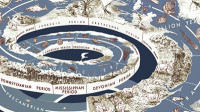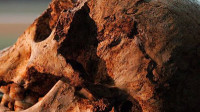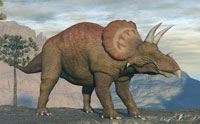Five seafloor scour troughs show tell-tale signs of having been gouged out by colossal icebergs. But none of today’s icebergs are nearly big enough to scour the seafloor at such a great depth. More… …read more Read more here: icr.org
Dreadnoughtus was a gigantic titanosaurian sauropod dinosaur that was wonderfully preserved in sedimentary rock but is not evidence of evolution but of creation and Noah’s Flood. …read more Read more here: creation.com
Evidence of runoff from Noah’s Flood …read more Read more here: creation.com
In spite of numerous attempts for over 60 years to determine the 87Rb half-life and decay constant, there is still no consensus. …read more Read more here: AIG Daily
What do erosional features on the earth’s surface suggest for the placement of the post-Flood boundary in the rock record? …read more Read more here: creation.com
Crazy-looking fossil’s evolutionary descendants are crawling around in the tropics, evolutionists say. …read more Read more here: AIG Daily
Arthropods moult in mere minutes, yet this ancient specimen was caught in the act, showing disaster struck suddenly, like the Bible says. …read more Read more here: creation.com
The battle of world views is often most fiercely contested when it concerns the believed age of rocks. Northern Ireland’s Giant’s Causeway illustrates this particularly well. …read more Read more here: creation.com
Circular Reasoning in the Dating of Deep Seafloor Sediments and Ice Cores: The Orbital Tuning Method
The different dating systems are calibrated to one another: dates assigned to the seafloor sediments are used to date the ice cores, and vice versa. …read more Read more here: AIG Daily
Natural Trap Cave preserves a treasure trove of animals from the Ice Age until the 1970s. …read more Read more here: AIG Daily
Noah’s Flood explains Hopewell Rocks, Canada. The Bay of Fundy in eastern Canada is famous for its enormous tides. At Hopewell Rocks, toward the end of the bay, the tide may rise as high as 14 metres (46 feet), but it does not stay high very long. The water is always moving, either up or down, and the level can change by a metre (3 feet) in 30 minutes.1 The tides are eroding the cliffs and leaving stacks that are narrow at their base and look like ‘flower pots’ standing on the shore. These have fascinating names like Baby Elephant, [More]
Indonesia’s Flores Island was probably populated not by a Lilliputian human species but just ordinary people including a person with Down syndrome. …read more Read more here: AIG Daily
The geological history of Brisbane and Ipswich Australia from a biblical perspective. One of the values of history is that it helps us understand where we have come from and so appreciate our place in the world. Our view of the past will inform the choices we make today, which also shape our future. Especially significant is our understanding of geological history, which provides the broadest and most basic picture of where we fit into the world. George Orwell said, “He who controls the past controls the future. He who controls the present controls the past.”1 How true. There [More]
Get used to seeing feathers on all evolutionary depictions of dinosaurs, not just theropods! …read more Read more here: AIG Daily
An international team of scientists discovered a new fossil in Chinese sediments famous for their supposed feathered dinosaur specimens. Like a handful of previous finds, this new example apparently had four wings. Fossil impressions show flight feathers extending not only from the front wings of Changyuraptor yangi, but also from a pair of hind wings, making this the largest four-winged creature yet found in fossils. More… …read more Read more here: icr.org
The eleven-year Hell Creek Project involved collecting fossils from the famous Montana Hell Creek Formation, including over fifty Triceratops specimens. The latest report from the project, however, reveals three “logic holes” in its attempts to answer questions about when and how these dinosaurs evolved. More… …read more Read more here: icr.org
What a storm it must have been! News reports said that hundreds of giant jellyfish once lived about 500 million years ago, but were ‘stranded by a freakish tide or storm’ on an ancient beach. Sand later buried them, forming fossils.1,2 With many specimens measuring over 50 cm (20 in) across, these are the biggest fossil jellyfish known. Found in a Wisconsin sandstone quarry, it must have been an extraordinary set of circumstances that preserved them, geologists say, for fossilized impressions of jellyfish, which have no skeleton or other hard parts, are extremely uncommon.3 “To preserve a jellyfish, that’s hard, [More]
Australopithecine’s fatal fall preserved this fine fossil in a post-Flood cavern collapse. …read more Read more here: AIG Daily
Rapidly formed fossils, and many that still contain carbon-14, defy the conventional wisdom of millions of years. …read more Read more here: creation.com
What is it? And is it evidence against the Bible’s age of the earth? …read more Read more here: creation.com
Stephen Czerkas digs dinosaurs. His early advocacy for feathered dinosaurs makes his recent reversal that much more remarkable. His reexamination of a fossil—one that had been known as a feathered dinosaur—reveals the fruits of taking a closer look at spectacular claims. More… …read more Read more here: icr.org
Researchers on the deep-drilling ship Glomar Challenger made a startling discovery back in the early 1970s. They discovered that the Mediterranean Sea is underlain by a thick ‘evaporite’ below hundreds of metres of sediments or sedimentary rock. This ‘evaporite’ is around one kilometre thick and covers about 2.5 million km2, based on seismic data. In the middle of the deeper basins, it could be as thick as 1.5 to 1.8 km. This ‘evaporite’ is one of many examples of ‘saline giants’ that have long been a problem for uniformitarian geology because of the lack of a modern analogue.1 For [More]
Does Mercuriceratops, like its mythological namesake messenger of the gods, bring us a mythological message from an evolutionary past? …read more Read more here: AIG Daily
Scientifically, it has never been a problem to explain that hard rock can form quickly, given the right conditions. …read more Read more here: AIG Daily
Evidence for a young earth and biblical history. …read more Read more here: creation.com
A famous fossil cave in Spain yielded human fossils from over two dozen ancient individuals. Investigators analyzed these human head bones and compared them with typical Neandertal skulls. Their findings, published in the journal Science, unwittingly support a biblical creation model for Neandertal origins. More… …read more Read more here: icr.org
The “mosaic” of traits in these people who left their fossilized remains in Ice Age sediment is consistent with the history found in God’s Word. …read more Read more here: AIG Daily














































